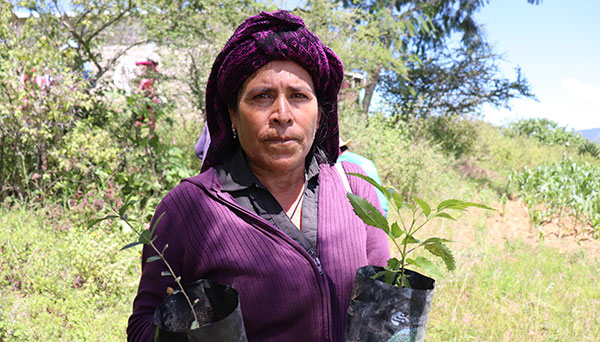Local Action to Mitigate Climate Change in Zapotec Communities of the Central Valleys of Oaxaca
Organization: Grupo para Promover la Educación y el Desarrollo Sustentable, A.C.
The mission of the Group for the Promotion of Education and Sustainable Development (Grupo para Promover la Educación y el Desarrollo Sustentable, A.C.—Grupedsac) consists of education, training, and actions that contribute to developing sustainable communities and societies.
Location: Municipalities of Coatecas Altas, Ejutla de Crespo, and Santo Cruz Monjas, Oaxaca. Communities in Coatecas Altas: Chepeginio, Coatecas Altas and Tepehuaje. Communities in Santa Cruz Monjas: Santa María Velato and Río Anona. Communities in Ejutla de Crespo: El Sauz, La Lobera, Barranca Larga, Yegoseve, Guelaxico, Monte del Toro and El Arrogante Justo Benítez.
Country: Mexico
Other Organizations Involved: Propuesta para la Sustentabilidad, A.C.; Sikanda; the Sola de Vega Institute of Technology; the Central Valleys Technological University of Oaxaca; Flor y Canto, A.C.; Education and Forestry Training Center (Cecfor) No. 2; the Oaxaca Valley Institute of Technology; the mayors of three municipalities; municipal agents from the participating communities.

©GRUPEDSAC
Background
This project responds to the conditions arising from the prevailing social, environmental, and economic inequality in Zapotec Indigenous communities. It will, however, have a somewhat different focus, more centered on the women in the affected villages, whose status is further disadvantaged by poverty and their Indigenous identity. In the last six years, the effects of climate change have endangered the flora and fauna biodiversity which have long sustained nutrition and traditional ways of life in these communities, especially in relation to women. Water shortages (sources are scarce or erratic) and droughts (often persistent) are endemic in the region. Moreover, soil erosion is an issue, as is habitat loss affecting species crucial for human subsistence, such as stingless bees, which pollinate wild and cultivated plants essential for food, natural medicines and timber production. The loss of plant cover due to natural factors, such as runoff and wind, is accentuated by goat grazing, which is very extensive in the region. Unfortunately, many highly nutritious species of plants appear increasingly rarely on local families’ tables. In the last three years, this situation has also been aggravated by the massive market penetration of industrialized products.
Goals
- Participating women make and operate a “stingless bee house” to care for and reproduce these vital pollinators.
- Establish a plant nursery for hopbush (Dodonaea viscosa) and copal (Bursera copallifera) reproduction.
- Establish 50 agroecological farming units, operated by women participants, for small-scale comprehensive production in 50 homes.
- Establish 50 biofactories, after providing training and practical workshops to participating women.
- Produce 10,000 hopbush and copal plants in the plant nursery.
- Protect 25 hectares of dry tropical habitat and ensure substantial improvements in their management.
- Hold three training sessions around three core topics—body, land and territory—to build Indigenous leadership through participatory workshops.
- Hold three women’s meetings to formulate a local collaborative agenda on biodiversity stewardship and the response to the effects of climate change in the three municipalities.
- 50 women become active as seed custodians in the three participating municipalities.
- 50 women participate in the drafting of a regional work plan on biodiversity and life.
Main activities
- Creation and equipping of a “stingless bee house,” in conjunction with the training of 50 women on the comprehensive management of these pollinators and the harvesting of their honey and other byproducts.
- Creation of a plant nursery for hopbush (Dodonaea viscosa) and copal (Bursera copallifera) reproduction.
- Establishment of small-scale, comprehensive agroecological production units.
- Creation of biofactories to support soil care by means of corrective additives for women participants’ farmland.
- Production of 5,000 hopbush and copal plants.
- Protection of 25 hectares of dry tropical habitat, as a result of the comprehensive training given to women’s groups.
- Training of women’s groups on three core topics—body, land and territory—to build Indigenous leadership.
- Holding women’s meetings to formulate a local collaborative agenda on biodiversity stewardship and response to the effects of climate change in the three municipalities.
- Establishment and consolidation of a network of native seed custodians in the three participating municipalities.
- Elaboration of a regional plan for women’s participation in the care and protection of biodiversity and life.
Outcomes
- 50 women participants have learned to care for and reproduce stingless bees and know how to fully manage their honey production and that of other derivative byproducts.
- 5,000 hopbush (Dodonaea viscosa) and copal (Bursera copallifera) plants are produced (sown and cared for) per year, i.e., 10,000 plants in total during the project.
- 50 women will now have an operational agroecological farming unit for small-scale, comprehensive production, enabling improvements in their families’ nutrition and in soil care.
- 50 women will have operational biofactories, having received training and participated in hands-on workshops to build their capacities and know-how.
- 50 women implement and replicate habitat protection principles through collective actions.
- 50 women are trained—through in-person workshops—on three core topics—body, land, and territory—to build Indigenous leadership, which may then be further developed through participatory workshops.
- 2,000 persons participate in women’s meetings to formulate a local collaborative agenda on biodiversity stewardship and the response to climate change in the three municipalities in Oaxaca.
- A consolidated network of women become active as seed custodians in the three target municipalities.
- A regional work plan with a focus on gender rights and equity has been drafted by 50 women participants.